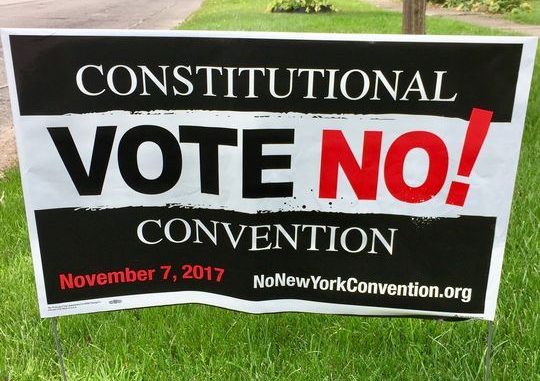
After expressing varying levels of ideological opposition to a public referendum present on the back of the ballot, New Yorkers in opposition to the Constitutional Convention have the majority vote. New Yorkers, through this decision, have chosen not to utilize their inalienable right to alter the constitution in cases where the interests of the people and the legislature conflict.
On Tuesday, Nov. 7 New York voters had their say when they rejected Proposal One on the back of the voter’s ballot. The choice in question was whether the state should open the state’s constitution in an effort of a reboot.
With over 80 percent of voters’ opposition, the ballot measure was defeated, ceasing any opportunity for what is commonly referred to as “ConCon.”
The State Constitution calls on the public to hold referendum on these conventions every twenty years. The last time voters opened the floor for a convention was 1967, rejecting the ballot measure in both 1977 and 1997. The last convention was still responsible for little change, any and all suggestions having been rejected by the same electorate that had opened the floor.
According to The New York Times, progressive supporters of the convention met concerns of radical change to the constitution by leveling that any proposed revisions made by delegates would have to later be approved by voters in a separate referendum. Should the results have turned out differently, voters would have been called to make decisions on any alterations in November 2019.
A major point of contention for voters lies in the cost of holding a convention. In 1967, the convention cost a total of $6.5 million to stage. Estimates place a current convention from anywhere to $50-100 million.
United University Professions (UUP) was quick to take a stance on the matter.
In a press release the union cited the potential cost being a deciding factor in why the public should vote against the ballot measure.
“There are far better ways to spend our money than on a constitutional convention,” UUP wrote.
UUP explained that the money used to stage a convention could be utilized to cover doctors’ visits for 625,000 New Yorkers, a year’s worth of meals for 163,333 children and tuition for 3,864 state residents to attend a SUNY school for four years.
In a Siena College Research Institute survey released Nov. 1 found Proposal One, which would require the state to hold the constitutional convention, failing by a margin of 57 percent to 25 percent.
According to The Washington Times, 60 percent of respondents called it “an expensive waste of time.”
Gov. Andrew Cuomo, originally having supported the call for convention, voiced his decision to vote no on the ballot Monday, according to his office.
Cuomo’s reasoning stems from his belief that the current delegate system does not offer enough protections to prevent the status quo and special interests from governing.
SUNY New Paltz Political Science Professor Stephen Pampinella commented on the intense rigor of the anti-constitutional convention campaign, citing it as having decisively shifted the voters’ choice.
According to a Siena College poll taken in September, 45 percent of New York voters had supported the convention compared to 33 percent who opposed it.
“It’s not clear either that the convention would necessarily be stacked against the anti-con-con interest groups, including unions,” Pampinella said. “They would likely be able to influence the convention and protect the rights of public sector employees already enshrined in the State Constitution, but it would require a well-funded political campaign that would dwarf their spending on the ‘no’ vote; for them, it appears that the status quo in Albany is less costly.”
